| |||||||
 |
| Search this Thread |  41,993 views |
| | #1 |
| Team-BHP Support  | Toyota Hybrid Technology: Drive & Experience @ Japan Ever seen a Toyota logo with a blue tinge as shown below? It is the honour badge of a Toyota car powered with hybrid technology. 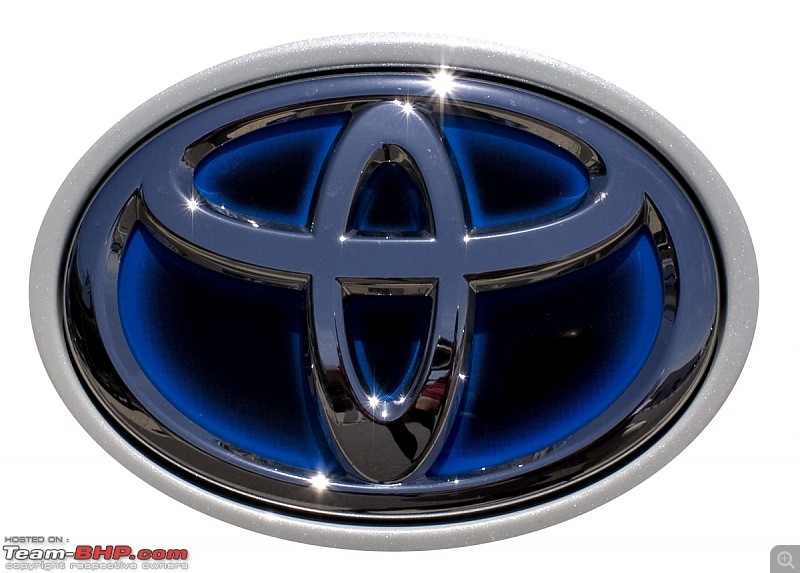 Most of us have heard about hybrid cars to a different extent over the last 15 years. I first did in 1999 when the Honda Insight was launched as the first production hybrid in the USA. It looked like a cross between a car and a spaceship! After the initial curiosity faded, most forgot about it. However, a few months later, the Toyota Prius was launched in USA. And this looked like a normal car...something a regular Joe would consider buying. The Toyota Prius was a practical enough car if you were willing to pay a little extra for the green tag and higher fuel efficiency, while settling for lower power ratings. But gasoline was still 99 cents a gallon, so the Prius didn't rise too high on most car buyer’s radars. Still, it became the darling of the green brigade, and of people who wanted to project a green image. Toyota had launched the Prius in Japan in 1997, two years ahead of Honda. The Prius is the world’s first production hybrid car, and it looked like a normal automobile from the very first iteration. The Prius did pretty well in Japan, where the fuel cost has always been high. For instance, last month's price of petrol and diesel were Rs.82 and Rs.72 respectively. Last edited by GTO : 11th June 2013 at 22:02. |
| |  (19)
Thanks (19)
Thanks
|
| The following 19 BHPians Thank Samurai for this useful post: | 9thsphinx, ashpalio, Auswechseln, aviorp, condor, DicKy, dZired, GTO, IronH4WK, Jaggu, JoseVijay, noopster, Rehaan, Researcher, suhaas307, theexperthand, V.Narayan, vb-saan, Venom_rider |
| |
| | #2 |
| Team-BHP Support  | re: Toyota Hybrid Technology: Drive & Experience @ Japan About a decade later, the Toyota Prius was launched in India. However, the initial interest didn't last long, especially after the astronomical price of Rs. 27 lakhs was revealed. The primary reason for the high price was that the Prius was imported as a CBU (completely built unit) and the lack of government subsidies for eco-friendly cars. Honda had launched the Civic hybrid at 21.5 lakhs and even then, it simply found no takers. As far as the market was concerned, hybrid was just another buzzword. The only way Honda could clear up its stocks was by resorting to a Rs. 8 lakh price cut. In Jan 2013, Indian Prime Minister Manmohan Singh unveiled the National Electric Mobility Mission Plan (NEMMP) 2020 that sets the vision, lays the targets and provides the joint Government – Industry vision for realizing the huge potential that exists for efficient & environmentally friendly electric vehicle technologies (including hybrids) by 2020. With that, hybrid cars are guaranteed to receive direct subsidy, reducing the cost of ownership. Toyota obviously wants to take full benefit of this development. The next logical step would be to educate the market about hybrid technology, and make a clear distinction between hybrid and traditional vehicles. With that goal in mind, Toyota invited about 25 media houses from 5 Asian countries (India, Indonesia, Malaysia, Pakistan & Philippines) to Japan, to experience hybrid technology up close. I represented Team-BHP at this event. We visited the Toyota HQ at Toyota City (near Nagoya). We visited the Toyota Ecoful town to understand how the company has extended green technology beyond cars. We test drove different hybrid cars at the Spa Nishiura Motor Park race complex. Finally, we also toured the factory that makes the most important part in a hybrid, the battery. Last edited by GTO : 11th June 2013 at 09:53. |
| |  (15)
Thanks (15)
Thanks
|
| The following 15 BHPians Thank Samurai for this useful post: | 9thsphinx, ashpalio, Auswechseln, aviorp, condor, DicKy, GTO, Jaggu, JoseVijay, julyone_modi, Rehaan, Researcher, suhaas307, theexperthand, Venom_rider |
| | #3 |
| Team-BHP Support  | re: Toyota Hybrid Technology: Drive & Experience @ Japan The Physics Alright, let’s talk about hybrid technology. In order to truly understand hybrids, you’ll have to start with the basics.
The first one is among the most basic laws of Physics. One does not create or destroy energy, but we are always changing their form in order to get anything done. For example, you eat food in order to stay strong and do useful work. That is an example of chemical energy in food getting converted into physical energy. Now if you turn a handheld dynamo, physical energy is converted into electrical energy. But no conversion is 100% efficient; you will also find your body heated in the process, which means some physical energy was converted into heat and released into the air. Even if you merely lift a brick from the ground, you converted physical energy into gravitational potential energy. If you drop the brick, that gravitational potential energy gets converted to kinetic energy and smashes into the ground converting to impact energy. As you can see, energy keeps changing shape whenever you do any work. It is never created from nothing, nor destroyed into nothing. The second one is a bit easier to explain. Whenever you get an object to move using any kind of energy, it converts into kinetic energy. If you throw a rock, the force you used to throw the rock is now the kinetic energy of the rock. When the rock hits the target, the kinetic energy converts to impact energy, possibly destroying / damaging the target. In a gun or cannon, the explosive energy of gun powder is converted into kinetic energy once the projectile (bullet or cannonball) is speeding through air. It will also heat up the air it is passing through, therefore some kinetic energy is converted to heat too. If there is no target, the projectile will continue in motion until air friction and gravity overcome the residual kinetic energy. That is the end of the Physics lesson. Let's now apply these laws to a conventional car. Petrol has loads of energy. When petrol is ignited, it moves pistons in a certain order and gets the crankshaft to rotate. That means the chemical energy of petrol is now converted to rotational energy or torque. When this torque is transmitted via the gearbox, differential and drive shaft to the wheels, the car starts moving. That rotational energy is now converted to kinetic energy. In other words, the moving car has kinetic energy. The heavier the car, the faster the car, more is the kinetic energy of the car. So what happens when you apply the brakes? The brake pads rub against the brake disc, providing friction against the rotation of wheels. The car will start slowing down. The kinetic energy of the car quickly converts into heat energy, due to friction between the brake pads and brake disc. The brake disc and the steel / alloy wheels attached to it can get really heated up during this process, but the heat is eventually released to the air from the brake disc and wheels. In other words, kinetic energy is always entirely converted to heat and released to the air during the braking process. It is a colossal waste of energy! What if this energy can be stored instead? Hybrid cars are capable of using this kinetic energy to generate electricity and store it in a highly efficient battery. Then, they use this stored energy to run the car whenever possible. The braking process that converts kinetic energy to electric energy is called regenerative braking. Last edited by GTO : 11th June 2013 at 11:19. |
| |  (17)
Thanks (17)
Thanks
|
| The following 17 BHPians Thank Samurai for this useful post: | 9thsphinx, amitwlele, ashpalio, aviorp, condor, Desmosedici, GTO, Jaggu, JoseVijay, julyone_modi, Rehaan, Researcher, suhaas307, sups, theexperthand, V.Narayan, Venom_rider |
| | #4 |
| Team-BHP Support  | re: Toyota Hybrid Technology: Drive & Experience @ Japan The 3 types of Hybrid Systems 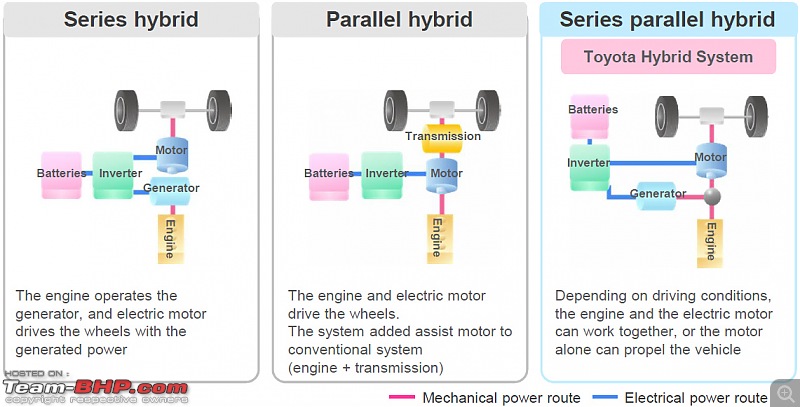 Series Hybrid: The engine will only operate the generator, which in turn charges the battery. The transmission is driven by the electric motor, which is powered entirely by the battery. This is a very simple system, but not the most efficient one. Here, the torque generated by the engine always undergoes two transformations before reaching the transmission. That is, Torque -> electricity and electricity -> torque. Each transformation results in some losses. Parallel Hybrid: The engine as well as the battery can run the motor, which in turn drives the transmission. When the battery is drained, only the engine turns the motor. Series Parallel Hybrid: This is Toyota’s original hybrid system. It is the combination of series and parallel hybrid systems. Using a power-split device, the engine can selectively drive the wheels or the generator, or both, depending on driving conditions. This arrangement is considered the most efficient. If you want a deeper understanding of the power-split device via animated and interactive aids, take a look at this link. Some of you may be wondering about the regenerative braking, and how that works in the above-mentioned hybrid types. Before you go there, you need to know one more thing. A motor is also a generator. If you supply electrical power to it, the shaft starts turning, acting like a motor. However, if you turn the shaft using external force, the armature will generate electric power, acting like a generator. In all of the above hybrid types, as one starts braking or lets go of the accelerator pedal, the wheel driving motor becomes a wheel driven generator. The resistance to turning of wheels comes from the regenerative resistance of the motor turned generator. This generated power charges the battery. If you want to learn more about motor / generators, take a look at this link. The Toyota Hybrid System makes the best use of the high efficiency operating area of an engine. 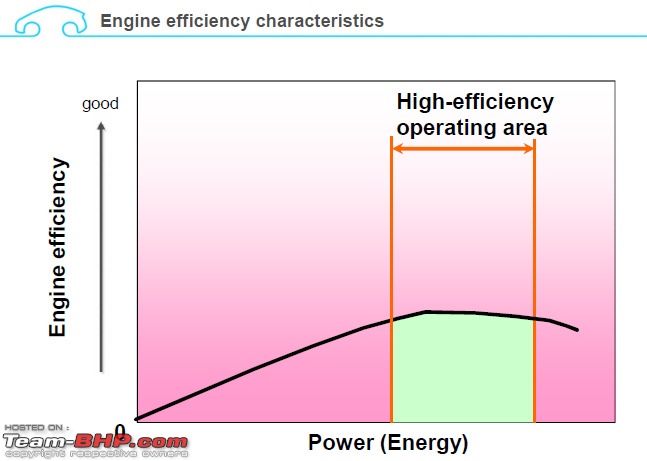 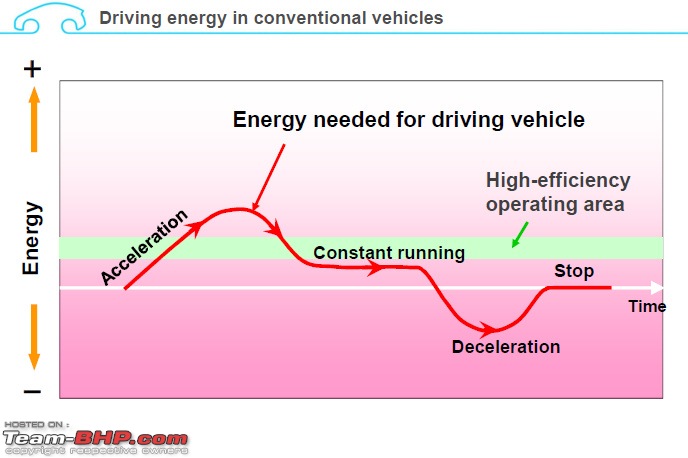 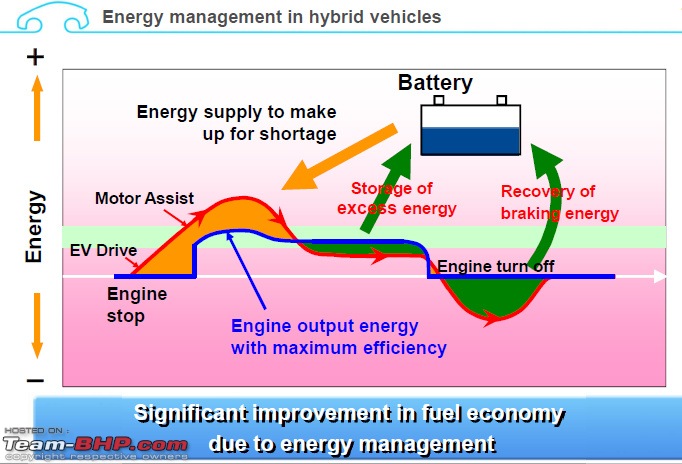 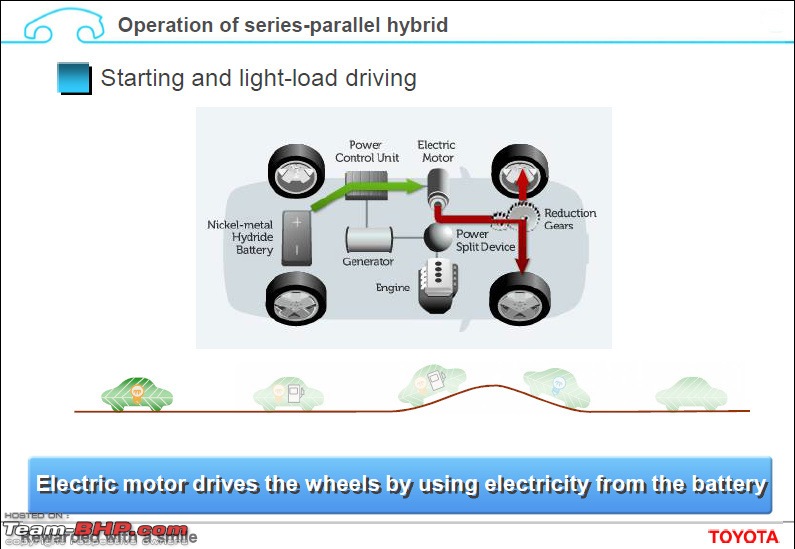 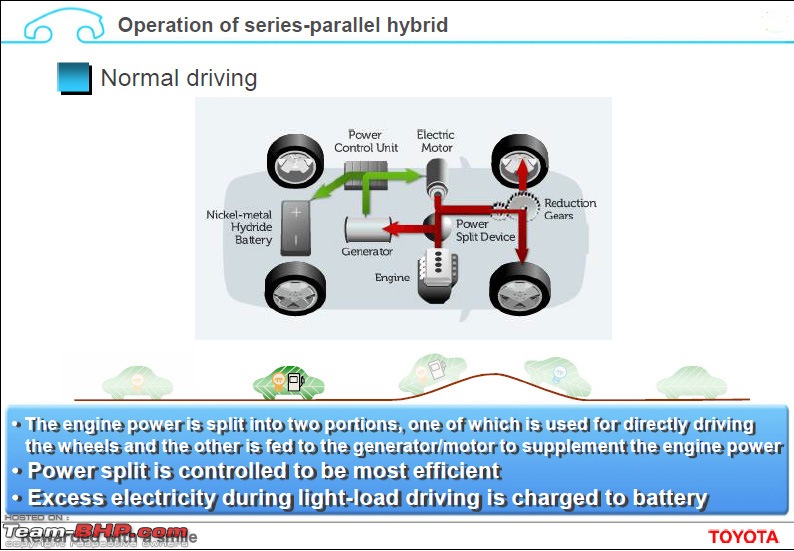 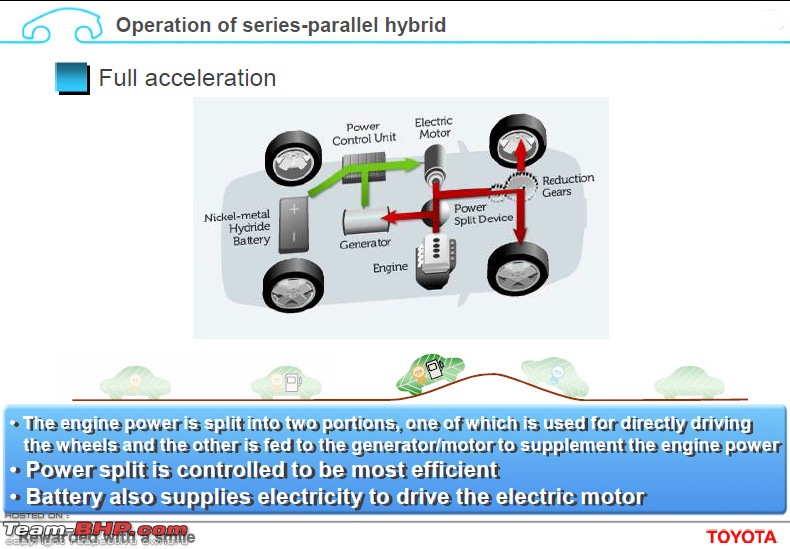 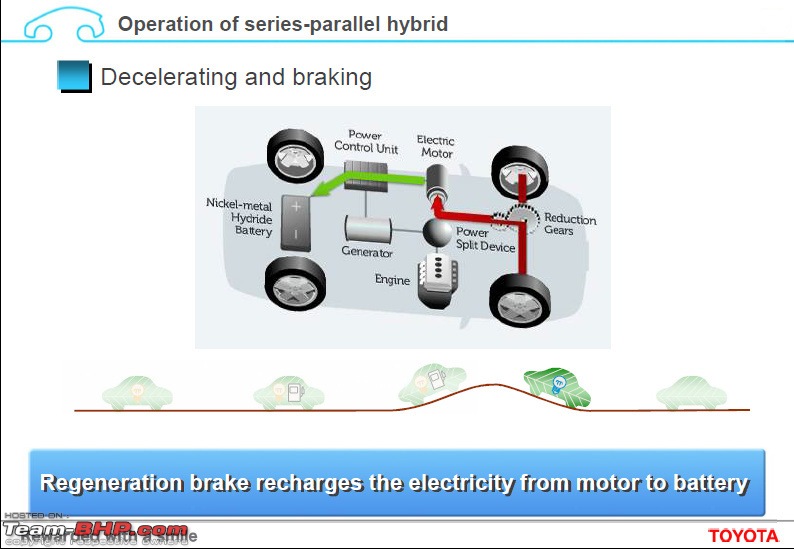 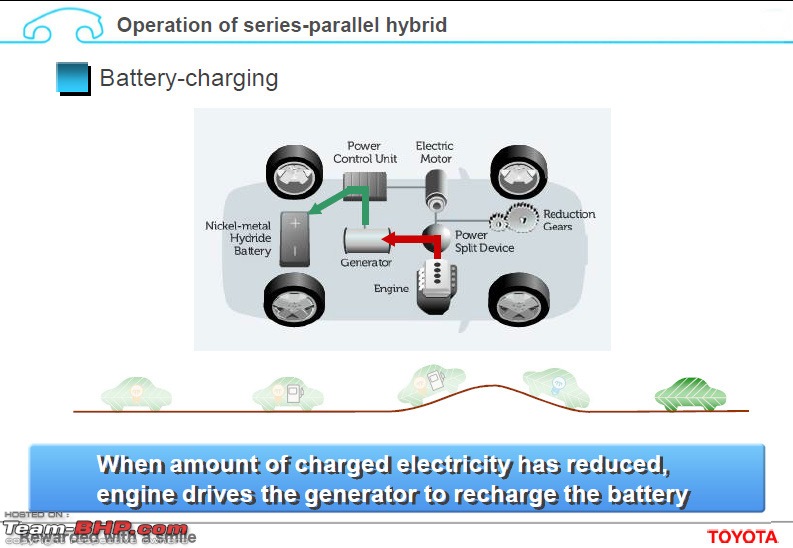 The first-gen Toyota Hybrid System (THS) was used in the Prius from 1997 to 2003. The current generation is called Hybrid Synergy Drive (HSD). The HSD is a drive-by-wire system that has no mechanical connection between the engine and the accelerator / gearshift. It is fully electrical. While we are still contemplating on Hybrid Vehicle (HV) technology, Toyota has moved on. They realised that the energy loop need not remain closed within the car. In traditional HVs, the battery is charged from two sources, the engine and the regenerative braking. So they added another way to charge the battery, the plugin feature of an electric car (EV). While this is a cross between HV and EV, the resulting Plugin Hybrid has a far longer driving range than a typical petrol car, let alone electric vehicle. Here is another whammy: not only can you use the plugin feature to charge the car, but you can also use the car to power your house! Imagine this, the regenerative braking you did while driving home can be used to power your house while watching TV that night. More on this in the Toyota Ecoful Town report. Last edited by GTO : 11th June 2013 at 12:37. |
| |  (26)
Thanks (26)
Thanks
|
| The following 26 BHPians Thank Samurai for this useful post: | 9thsphinx, amalji, ashpalio, aviorp, condor, deshmumn, Desmosedici, devilwearsprada, devsoftech, ecosport rules, GTO, Guna, Jaggu, JoseVijay, Kwanza, manolin, naadopaasaka, procrj, Rehaan, Researcher, suhaas307, sups, theexperthand, V.Narayan, Venom_rider, VijayAnand1 |
| | #5 |
| Team-BHP Support  | re: Toyota Hybrid Technology: Drive & Experience @ Japan The Driving Experience All the technical jargon sounds impressive, but how much of this is experimental, how much is practical?! Toyota arranged for test drives at both, the racetrack and public roads. There were 4 different types of driving conditions: 1) Toyota EcoRun Challenge. The idea was to do two sessions of a 3 lap run around the racetrack, while maintaining reasonable pace with good fuel efficiency (FE). Driver with the best FE wins, although you can get penalty points for driving slow. The track was 1.52 kms long and we were supposed to cover it in 1:50 minutes / lap. That roughly translates to an average speed of 50 kph over 3 laps. Doesn’t sound like much but remember, we had to do it in a hybrid car (Prius HV) on an unfamiliar track.  There was a demo drive of 3 laps by a professional racer who obviously knew every curve like the back of his hand. He took each curve without sacrificing any speed, and scaring the hell out of us. I think he did it in less than 1:50 minutes, but I knew even 2 minutes will be a hard one to pull off. The Toyota Prius has average power and handling characteristics, typical of C segment petrol sedans in India. When I drove it, after the first lap, I stopped looking at the FE meter. I focused on getting the improbable 1:50 minute lap timings. The Prius had a lot of body roll over fast turns and was slow to accelerate after the curves. At the end of the first round, I had achieved about 25 kpl fuel efficiency. I was also at the top of the FE chart in my group. Thus, I decided to continue driving using the same strategy in the second round. It made more sense just to drive using common sense, rather than than letting the FE meter dictate the driving style. In fact, that is how one should drive a hybrid...using common sense. You don't have to alter your driving style to drive an HV at all. Later, you'll see a video of how the hybrid system worked while driving on public roads. Some other journalists realised that the penalty for slow driving was minuscule. Therefore, many of them changed tactics and started driving awfully slow in the second round. They didn’t go fast on the straights, nor did they accelerate out of curves. On the other hand, I wanted to drive the car in real life driving conditions, so I continued to aim for the suggested speed and managed to do 3 laps in 5:45 minutes. That is about 1:55 minute per lap, while getting an average of 25 kpl. I was happy until I came to the results board and saw numbers like 33 kpl, 29 kpl, 27kpl etc. These were before the penalties kicked in. As I roughly calculated the penalties, I realised it hardly made a dent to their score. I truly salute the Indonesian pair who won the challenge. They managed 29 kpl while matching my driving time. I don’t have the result sheet with me, so my recollection of exact times may be a bit off. As I walked away from the event, it suddenly occurred to me that we got this kind of FE while driving a Prius hard on a racetrack. On a straight 4-lane highway, it could easily cross 30+ kpl. 2) The PHV Slalom Test The next test was of a very different car. The Toyota Prius PHV, powered by Plug-In Hybrid technology. 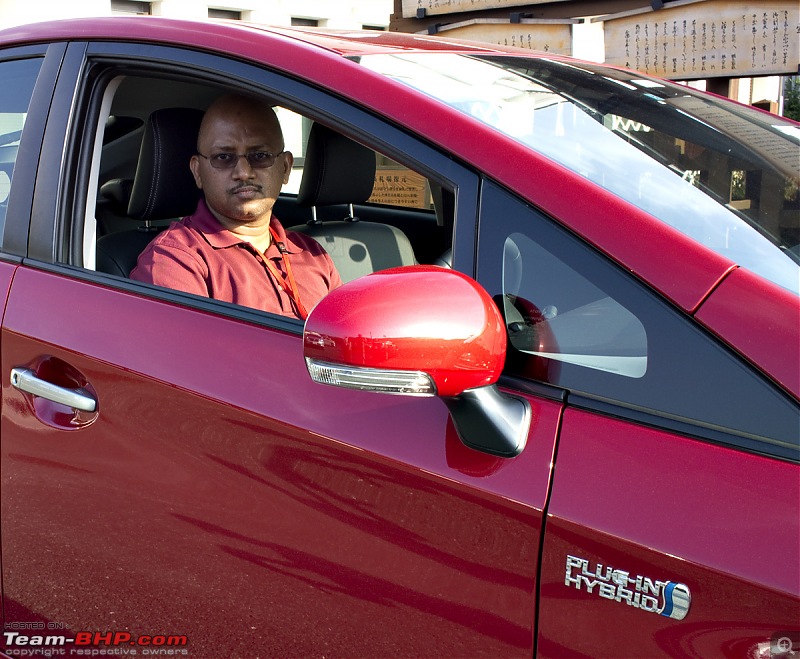 I wondered how different the Prius PHV can be than the regular Prius HV, at least in the driving dynamics area. Turns out that the difference is noticeable. The biggest change is the battery. While the HV is powered by a Nickel Metal Hydride battery of considerable size, the PHV is powered by a Lithium Ion battery that is almost twice as big, and has more than 3 times the power storage capacity. The battery is located behind the rear passenger seat. That’s like having a rear engine, in addition to the one at the front. That had to affect the driving dynamics, and I hadn’t been impressed with the Prius HV's handling on the track. Toyota offered a brief slalom test with two tight U-turns to prove that the BIG battery won’t affect on-road behaviour. I started smiling as I just love the curves. Then, the far-eastern scribe who was my driving partner for the PHV told me to drive both the rounds as she wasn't familiar with RHD vehicles. My smile only got wider. 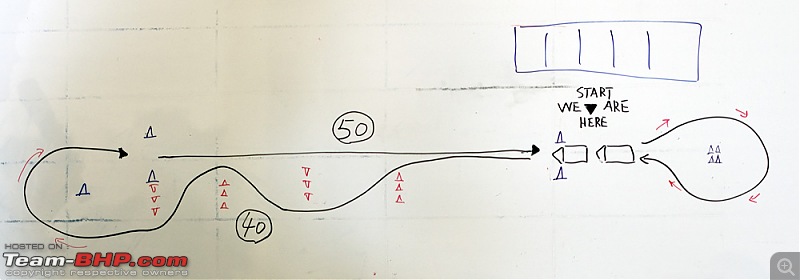 The number 40 refers to the top speed for the curves. The number 50 refers to the top speed for the straight stretch back. The top speeds were mentioned not for safety, but for demonstrating another feature of the PHV. And no, I don’t think they expected us to drift. So I took off, with a race driver on the passenger seat and the other scribe at the rear. I did the slalom at the best speed I could, pulled a very fast U turn and stopped. The race driver looked quite alarmed during the U turn! After we stopped, he looked around and added it was very smooth  . The PHV was absolutely composed during the crazy manoeuver. Although I didn’t get to compare it side by side with the Prius HV, I do feel that the PHV has better handling. One thing was amply clear, the heavy battery hardly affects the driving dynamics. . The PHV was absolutely composed during the crazy manoeuver. Although I didn’t get to compare it side by side with the Prius HV, I do feel that the PHV has better handling. One thing was amply clear, the heavy battery hardly affects the driving dynamics.I then took off on the straight stretch, not exceeding 50 kph, and ended the lap with another fast U turn. This time, the race driver was relaxed since he knew I could pull it off. Then, he asked me a strange question. He: Did you hear the engine come on? Me: Huh, I am not sure. He: You stayed below 50, so it never came on. Me: Aha, so that was the reason for the 50 kph limit!! Since I had another round, I paid attention to the engine this time. The slalom, fast U-turn, straight stretch, another U-turn and stop. The engine was never heard, because it never switched on! In the PHV, the engine doesn’t fire up unless you cross 50 kph or the battery runs out of juice. In Indian cities, we spend 95% of our driving time below 50 kph. A view from the dashboard. Take a look at the FE it managed even in the slalom tests: 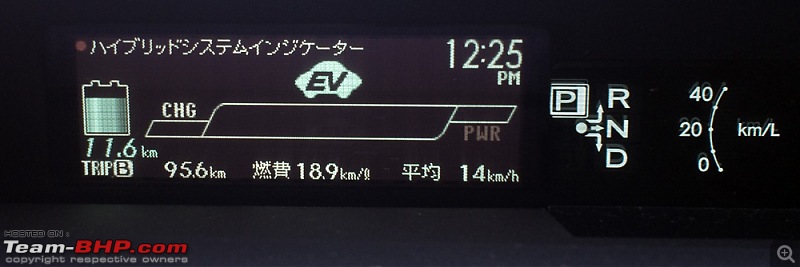 If the bar is at CHG, it indicates that the car is charging. If the bar is at EV, it indicates that the car is running on battery. If the bar is at PWR, it means the car is powered by the petrol engine. Notice how wide the EV part is. If you are driving on crowded roads, the engine stays shut. Don't expect the party to last long though. The car has limited range if you are just sticking to EV, perhaps as little as 20 kms. After that, the petrol engine will kick in and the battery will start charging again. My next concern was the trunk space. 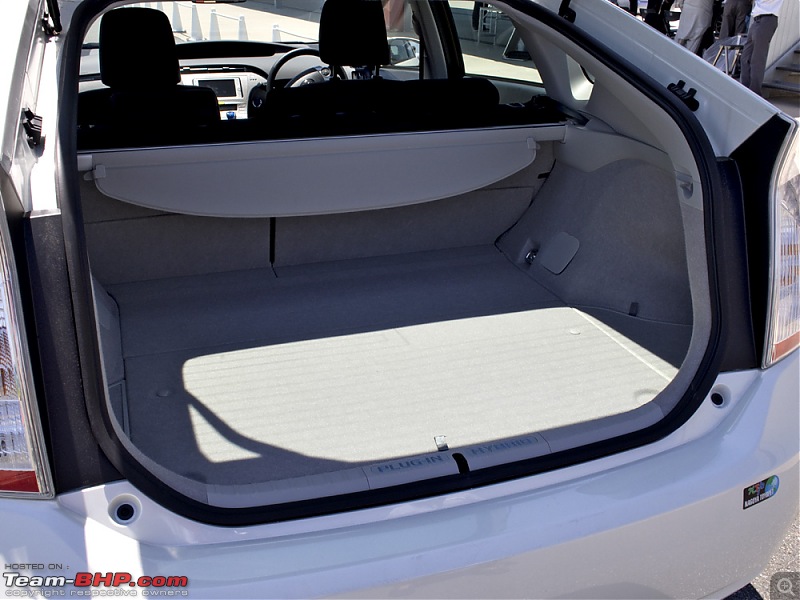 Umm, that’s a lot of space. Where is the battery? Well, you are looking at it. The entire trunk is above the battery. See the block under the trunk? That is the battery...the entire thing. The slim compartment next to the battery is used for parking the charging cable. Nope, no spare tyre in the PHV. 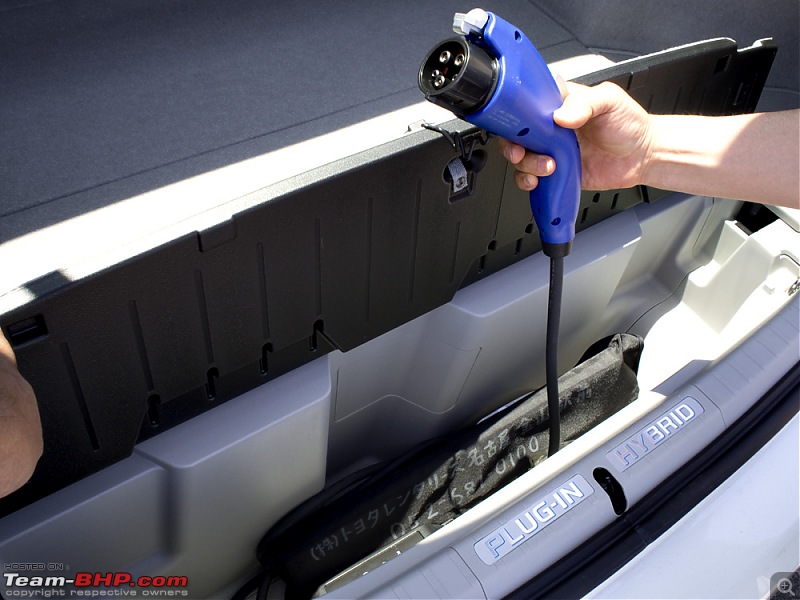 The PHV has a range of 870 kms under normal driving conditions. What is the FE of a PHV? That is a good question, but very hard to answer. How does one account for the external power? It may have different costs depending on whether the external power source was home-made solar or from the energy company. It is surely better than the Prius HV, thanks to cheaper external power and a bigger battery. Even Toyota doesn’t try to answer this complex question. If you have more PHV questions, check this page out. 3) Multi-car Track Driving The 3rd test-drive consisted of driving 6 different hybrid vehicles on the track. The line-up had the Toyota Sai (same as Lexus HS250h), Toyota Camry, Toyota Crown Comfort, Lexus GS450h, Toyota Estima & Toyota Alphard. Keep in mind that all hybrid cars have CVT transmissions, and this is track driving we're talking about. I went in with low expectations and came out impressed. What I am trying to say is, all of them felt like regular automatic cars to drive. The Estima and Alphard are actually minivans which I drove in sports mode, just for kicks. I was most impressed by Sai since it had the best handling of them all. It surely stood out on the track. Here's some interesting trivia. Japan has more than twice as many vehicles as India. While Indians own 18 cars per 1000 people, the Japanese own 591 cars per 1000 people. Toyota has 45% of Japan’s market share in passenger cars. Currently, 40% of Toyota’s domestic number is made up of hybrids. That alone should put all our doubts about the maturity of hybrid cars to rest. This also made me understand why Japanese cities are full of parking lots. I saw more parking slots than people on the road. 4) Public road driving. Later that day, we got to drive these cars on public roads. I chose the Sai since I loved driving it in the morning. I also preferred the Sai because it displays the hybrid system status via animation. You can see exactly when the motor is driving the car, when the car is charging the battery, when the engine is running the car etc. Japanese rural roads can be really narrow (not too different from India). But the complete lack of pedestrians and extremely courteous drivers make for an incomparable driving experience. Last edited by GTO : 11th June 2013 at 22:13. |
| |  (18)
Thanks (18)
Thanks
|
| The following 18 BHPians Thank Samurai for this useful post: | 9thsphinx, amalji, ashpalio, condor, Desmosedici, ecosport rules, GTO, IronH4WK, Jaggu, JoseVijay, Rehaan, Researcher, sridhar-v, suhaas307, theexperthand, V.Narayan, vb-saan, VijayAnand1 |
| | #6 |
| Team-BHP Support  | re: Toyota Hybrid Technology: Drive & Experience @ Japan The Battery Toyota showed us exactly how the battery is constructed. A single cell has 1.2V, while 6 cells make a module. Then, a whole bunch of modules are sandwiched together to make the battery. We were not allowed to take our cameras inside the factory, thus I don’t have any photographs. I did find a website that describes the same. Click here. The Prius uses a battery stack of 28 modules, for a total of 201 volts. Different cars have a different number of modules. Each car model can have a different voltage battery. When I heard this, it got me wondering about the 12V battery in conventional cars. Since a regular car's electrical components work on 12V, how are they going to make it work with these 200-300V batteries. I was fortunate enough to discuss technical matters with Managing Officer Satoshi Ogiso himself over dinner. He has spent 30 years in Toyota as an engineer, and is known as the Prius Guru. I was one of the few who asked technical questions, and he was very responsive. Q: Is there a conventional 12V battery in Hybrid cars? If yes, is it charged by the alternator? A: Yes, there is a conventional 12V battery in hybrids. However, there is no alternator. The 12V battery is charged from the hybrid battery using a DC-to-DC converter. Q: Is the 12V battery used for starting the car? A: No, there is no starter in a hybrid car in the traditional sense. While starting, the main hybrid battery starts the electric motor and the car gets moving. When the car is being driven, the engine can be started by simply engaging the drivetrain that is already running. Q: How much of Kinetic energy is converted to electric power, and how much is wasted as heat energy in the conventional brakes? A: If you are just taking your leg off the accelerator or braking gently, the entire braking is provided by the generator. In that case, we convert 80% of the kinetic energy to electric power. However, if the conventional brakes kick in due to hard braking, the conversion can be as low as 50%. Q: A conventional lead acid battery has an efficiency of 75%. What is the efficiency of a hybrid battery? A: It is very high, up to 98%. This was stunning, I didn’t expect such a high value. The NiMH battery pack does get heated during the charge-discharge cycle. I guess that is where the 2% is lost. The battery pack has a fan driven air-cooling system. It draws cool air from the air-conditioned cabin, using a vent near the rear right door. However, it was not clear where the air was released after cooling the battery. It appeared as if the air was released back into the cabin. NiMH batteries can emit toxic fumes when damaged or burning. If the battery is cooled using cabin air, won’t a damaged battery send the fumes directly into the cabin? Toyota claimed such things don’t happen. They did add that, of all the cars severely harmed in the 2011 tsunami, none suffered battery damage. They do have a plan for recycling used hybrid batteries. The Nickel can be extracted back and the rest is turned into steel. They said the battery cannot be field repaired, or even dealer repaired. It has to be sent back to the factory for full replacement. However, I saw many youtube videos performing a field repair of the Prius battery. Right now, they have 4 battery plants, all within Japan. They are aware that they'll have to localize battery production if they have to sell hybrid cars in huge numbers abroad. The proposal is under consideration. Last edited by GTO : 11th June 2013 at 21:52. |
| |  (17)
Thanks (17)
Thanks
|
| The following 17 BHPians Thank Samurai for this useful post: | 9thsphinx, amalji, amitwlele, ashpalio, condor, Desmosedici, GTO, Guna, Jaggu, JoseVijay, manolin, mi2n, Rehaan, Researcher, suhaas307, theexperthand, V.Narayan |
| | #7 |
| Team-BHP Support  | re: Toyota Hybrid Technology: Drive & Experience @ Japan The Conclusion So, there you have it. The Toyota Hybrid Synergy Drive (HSD) Technology. What does that mean to Indian customers? We may now have a better understanding of the Prius HV that is offered in India, but its price is still too high for serious consideration. Toyota officials were tight-lipped about their Indian plans. Right now, Toyota has 19 Hybrid models across various segments. Not one of them will be coming to India to make use of the NEMMP. Instead, Toyota will be creating 18 new Hybrid cars in the next two years, some of which will come to India. There isn't a doubt that Toyota might be onto something big here. The price difference between petrol & diesel continues to get slimmer. Our high-traffic driving conditions are just the type that hybrids revel in. If Toyota sells mainstream hatchback & sedan hybrids that deliver stupendously high fuel economy, that can be a huge competitive advantage. An Official photo after the Test-Drive. 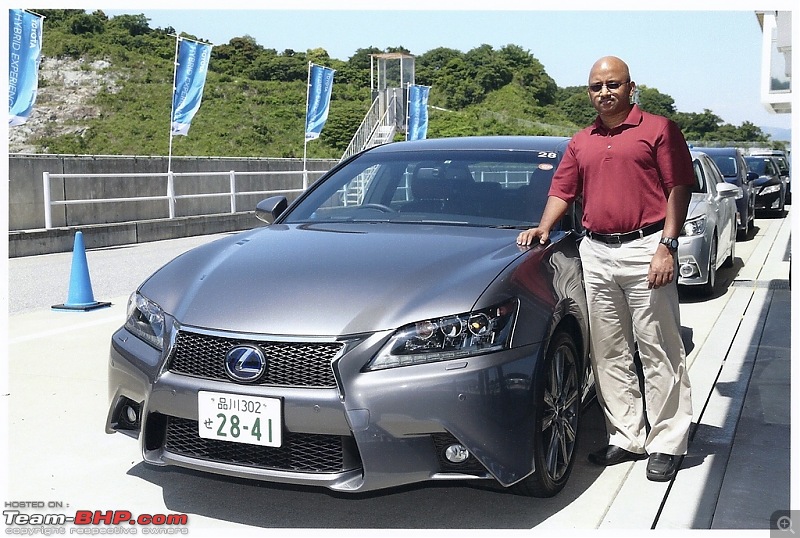 Disclaimer : Toyota Motor Corporation invited Team-BHP to Japan for the Hybrid Experience. They covered all the travel expenses. Last edited by GTO : 11th June 2013 at 21:58. |
| |  (15)
Thanks (15)
Thanks
|
| The following 15 BHPians Thank Samurai for this useful post: | 9thsphinx, amalji, amitwlele, Ashutosh, Auswechseln, condor, ecosport rules, GTO, JoseVijay, julyone_modi, Rehaan, Researcher, theexperthand, V.Narayan, VijayAnand1 |
| | #8 |
| Team-BHP Support  | re: Toyota Hybrid Technology: Drive & Experience @ Japan The Hybrids Lexus IS300h 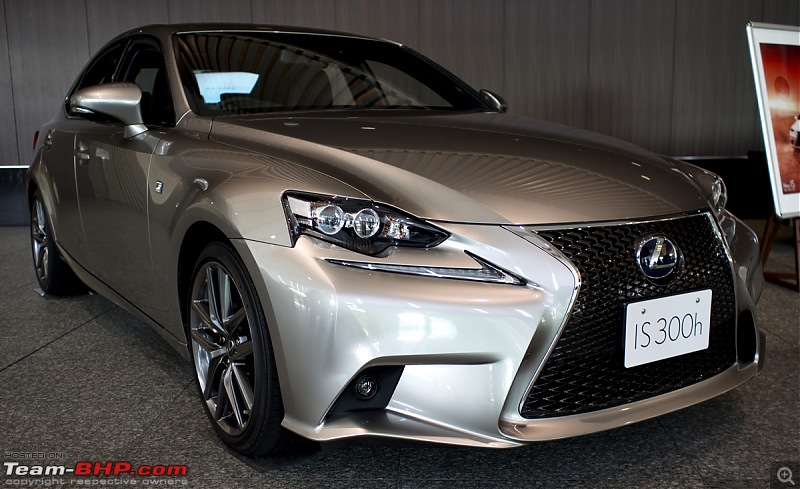 Toyota Prius PHV 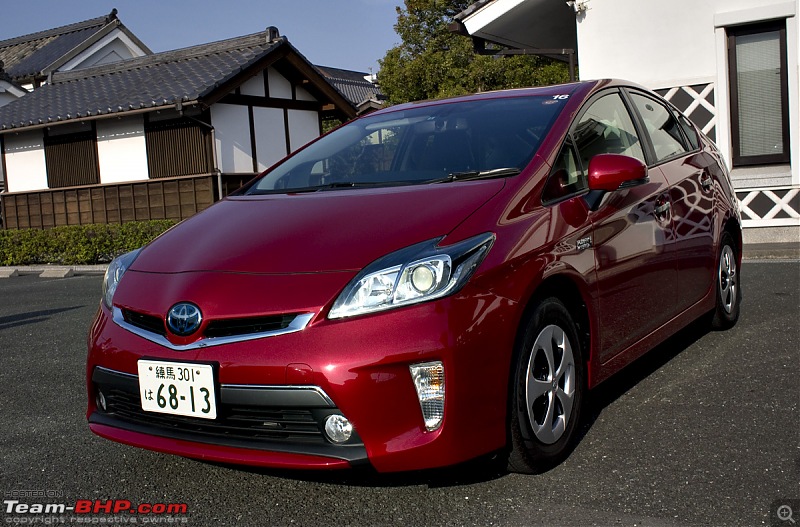 Lexus RX 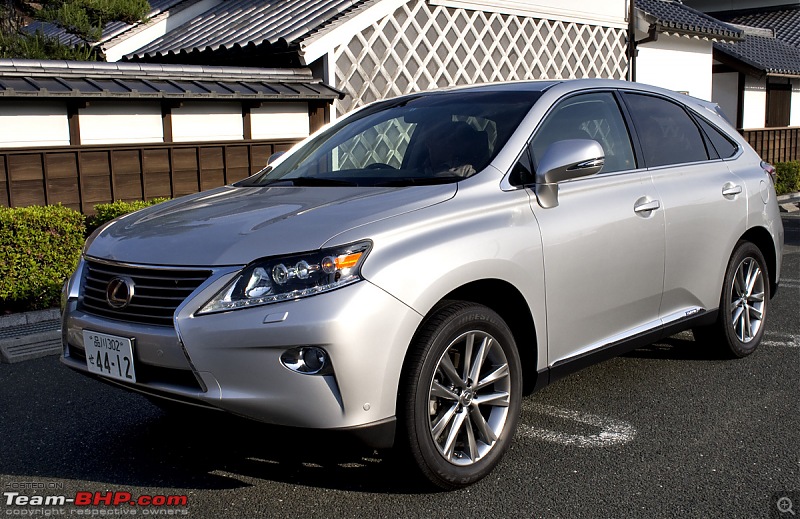 Toyota Alphard 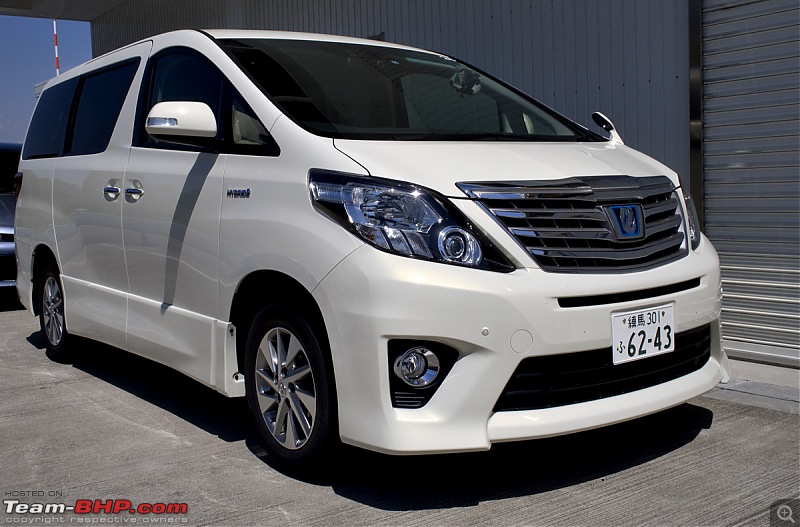 Toyota Estima 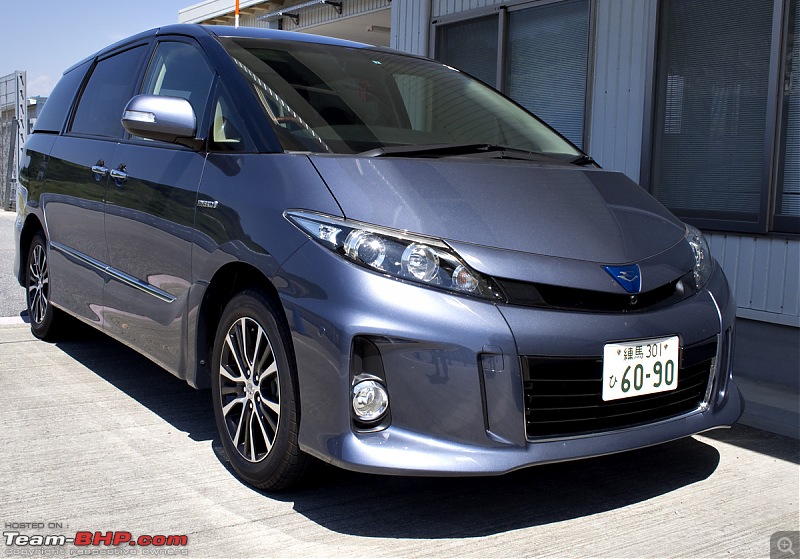 Toyota Sai 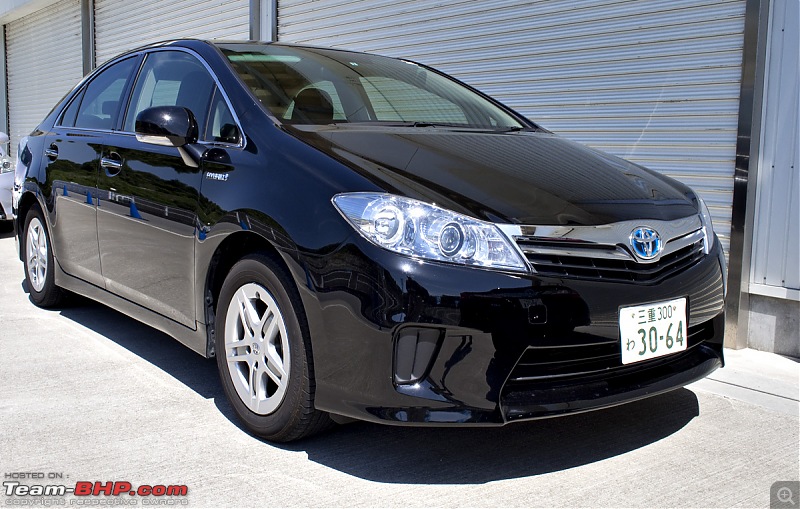 Toyota Camry 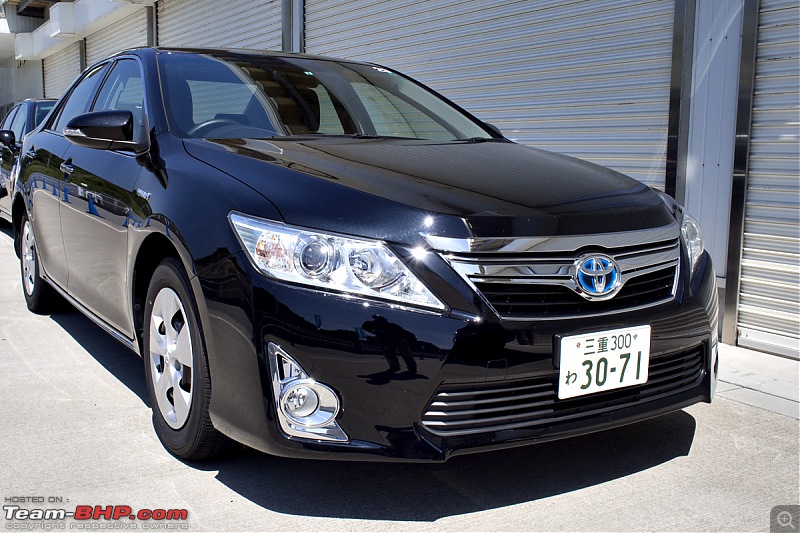 Last edited by GTO : 11th June 2013 at 22:00. |
| |  (27)
Thanks (27)
Thanks
|
| The following 27 BHPians Thank Samurai for this useful post: | 9thsphinx, Added_flavor, amalji, ashpalio, Batfreak, condor, dean5545, DicKy, DrPriyankT, ecosport rules, Grace, GTO, Guna, InControl, JoseVijay, mi2n, pulsar56, Rehaan, Researcher, RoadSurfer, speed kills, suhaas307, theexperthand, V.Narayan, Venom_rider, vidyanand, vijay_rodie |
| | #9 |
| Team-BHP Support  | Re: Toyota Hybrid Technology: Drive & Experience @ Japan Thread moved from the Assembly Line to the Technical Section. Thanks for sharing! |
| |  (2)
Thanks (2)
Thanks
|
| The following 2 BHPians Thank GTO for this useful post: | Researcher, Samurai |
| | #10 |
| Senior - BHPian | Re: Toyota Hybrid Technology: Drive & Experience @ Japan That is indeed a very knowledgeable thread. Rated it a much deserved 5 stars. I recently made a PPT presentation on Hybrid Cars and was on a lookout for some matter. But I can confidently say that this post contains every single point that I was unable to find on the net. Hybrids surely have a great potential to be used in India since most of our city driving never exceeds speeds of 50kmph. I just hope our government takes more steps like the National Electric Mobility Mission Plan (NEMMP) for encouraging manufacturers to jump in this automotive sector. PS: Never knew Japan had so many parking spaces. In India, we don't even have such open 'spaces', forget about parking spaces.  |
| |  (1)
Thanks (1)
Thanks
|
| The following BHPian Thanks dZired for this useful post: | Samurai |
| | #11 |
| Team-BHP Support  | Re: Toyota Hybrid Technology: Drive & Experience @ Japan
Thanks, but I am not surprised. Despite knowing about Hybrids since 1999, I was mostly ignorant about the technology. But Toyota has been slogging at this for nearly two decades. As a result they do have a huge first mover advantage. |
| |  (1)
Thanks (1)
Thanks
|
| The following BHPian Thanks Samurai for this useful post: | dZired |
| |
| | #12 |
| BHPian Join Date: Sep 2009 Location: Bangalore
Posts: 317
Thanked: 170 Times
| Re: Toyota Hybrid Technology: Drive & Experience @ Japan Thank you Sharath, for a detailed explanation of Hybrid technology in lay man terms for easy undertanding. The term "Hybrid" has been largely misunderstood by average Indian auto enthusiast, compounded by the manufacturer whether intentional or otherwise. Tech jargon like 'Micro Hybrid' does get one to wonder on what is Hybrid all about. However Tata Indigo Manza Hybrid Concept does seems to be spot on in Indian driving scenario, prices could be much controlled when produced in India. Toyota will have challenge in bringing about public awareness in case it wants to play number game for its Hybrid vehicle business. The cost is currently prohibitive. Any ways if the Indian government is serious on its measures to bring about NEMMP 2020 and offers tax incentive kinda sops for the manufacturer, it will go a long way to ensure a pollution free environment, highly efficient cars on Indian roads with fun to drive cars, what with Toyota having intially covered "kitna deti hai" question. Andy Last edited by Grace : 12th June 2013 at 11:51. Reason: syntax errors |
| |  (2)
Thanks (2)
Thanks
|
| The following 2 BHPians Thank Grace for this useful post: | GTO, Samurai |
| | #13 |
| BHPian Join Date: Oct 2009 Location: Zirakpur
Posts: 72
Thanked: 15 Times
| Re: Toyota Hybrid Technology: Drive & Experience @ Japan A great Knowledge Source. Rated the thread 5 stars, very well deserved. I wonder why this is not prevelant in India, the only thing comes to mind for cost being so high is zero localization. But I feel this is a time when Toyota should seriously think on manufactiring Hybrids in India. |
| |  (1)
Thanks (1)
Thanks
|
| The following BHPian Thanks rajesh.sml for this useful post: | Samurai |
| | #14 |
| BHPian | Re: Toyota Hybrid Technology: Drive & Experience @ Japan Do you consider their invite and your trip was a prelude to introduction of hybrids in India in a bigger way? Did you feel at home ( Japan ) Samurai ? Last edited by Thilak29 : 12th June 2013 at 12:39. |
| |  (2)
Thanks (2)
Thanks
|
| The following 2 BHPians Thank Thilak29 for this useful post: | GTO, Samurai |
| | #15 | |
| BHPian Join Date: Sep 2009 Location: Bangalore
Posts: 317
Thanked: 170 Times
| Re: Toyota Hybrid Technology: Drive & Experience @ Japan Quote:
Localisation is not the issue as entire CBU is imported and the duty payable is >100%  , so the car should actually cost only 12~14 lakhs, if the duty were to reduce, then I would be , so the car should actually cost only 12~14 lakhs, if the duty were to reduce, then I would be  to buy the car which Samurai says it will give average 29kmpl. to buy the car which Samurai says it will give average 29kmpl.Andy | |
| |  ()
Thanks ()
Thanks
|
 |


